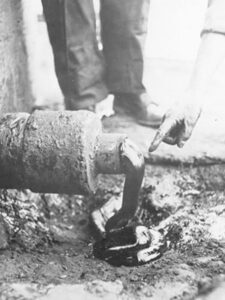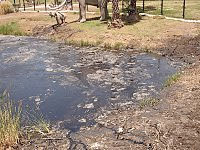Bitumen is a product of Crude oil Distillation. It is a semi-solid hydrocarbon product produced by removing the lighter fractions (such as liquid petroleum gas, petrol and diesel) from heavy crude oil during the refining process. As such, it is correctly known as refined bitumen.
“Asphalt Cement” or “Asphalt”
Commonly termed “refined bitumen,” it’s recognized as “asphalt cement” or “asphalt” in North America. In other regions, “asphalt” refers to a blend of small stones, sand, filler, and bitumen, constituting road paving material, with about 5% bitumen content. Maintaining stability as a semi-solid at ambient temperatures, bitumen has a rich historical background.
History of Bitumen
Dating back to the Sumerians in the third millennium BCE,  bitumen found varied uses in statuary, brick waterproofing, bath construction, and shipbuilding. Civilizations like Babylon, India, Persia, Egypt, Greece, and Rome continued these applications, with bitumen still binding structures today. Some interpretations of the Book of Genesis cite bitumen as the substance used in building the Tower of Babel. An ancient tunnel beneath the Euphrates reportedly employed burnt bricks covered in bitumen for waterproofing during Queen Semiramis’ time around 700 B.C
bitumen found varied uses in statuary, brick waterproofing, bath construction, and shipbuilding. Civilizations like Babylon, India, Persia, Egypt, Greece, and Rome continued these applications, with bitumen still binding structures today. Some interpretations of the Book of Genesis cite bitumen as the substance used in building the Tower of Babel. An ancient tunnel beneath the Euphrates reportedly employed burnt bricks covered in bitumen for waterproofing during Queen Semiramis’ time around 700 B.C
The word “bitumen” originates from Latin, while the Greek term “asphaltos” was used for it. Dioscorides in 40 A.D. described the production of asphaltos. The terms “asphalt” and “bitumen” are often used interchangeably for both natural and manufactured forms.
Judaicum Bitumen, renowned for its purity, emerged from native asphalt seeping through the Dead Sea’s diapirs. It was the subject of the first recorded conflict over a hydrocarbon deposit between the Seleucids and Nabateans in 312 B.C.
Geological origin of Bitumen
 Geologically, bitumen forms from ancient microscopic algae and other organisms. Their remains, deposited in ocean or lake mud, transformed under earth’s heat and pressure into substances like bitumen, kerogen, or petroleum. For instance, the La Brea Tar Pits showcase such deposits.
Geologically, bitumen forms from ancient microscopic algae and other organisms. Their remains, deposited in ocean or lake mud, transformed under earth’s heat and pressure into substances like bitumen, kerogen, or petroleum. For instance, the La Brea Tar Pits showcase such deposits.
Though bitumen shares structural similarities with organic matter in carbonaceous meteorites, detailed studies reveal their distinctness. Some speculate that certain bitumen might be primordial materials formed during Earth’s accretion and later modified by hydrocarbon-consuming bacteria.
So, bitumen, born from refined crude oil, has a storied past linked to various ancient civilizations and geological formations, remaining a versatile material in modern construction and industry.

